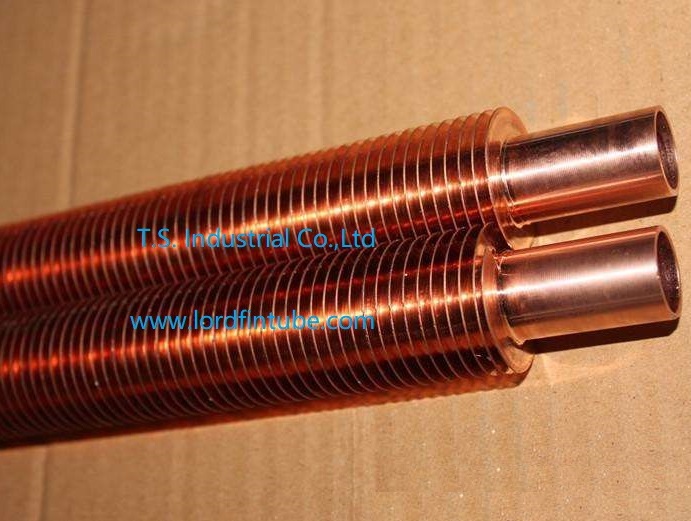Lord Fin Tube-Brazed spiral fin tube
Brazed Spiral Fin Tubes: The Ultimate Guide to Heat Transfer Efficiency
Brazed spiral fin tubes are a highly effective solution for heat transfer applications across various industries, including power generation, HVAC, petrochemical, and refrigeration. These heat exchangers feature spiral fins brazed onto a tube, creating an optimized structure for enhanced thermal performance and durability.
What Are Brazed Spiral Fin Tubes?
A brazed spiral fin tube is a type of heat exchanger where spiral fins are attached to a tube using the brazing process, which involves a filler metal with a lower melting point to bond the components. This design significantly increases the surface area for heat transfer, making it ideal for use in applications where efficient heat exchange is critical.
Features of Brazed Spiral Fin Tubes
Enhanced Heat Transfer: The spiral fin structure maximizes surface area, increasing the heat exchange capacity and efficiency of the system.
Corrosion Resistance: Materials like stainless steel and aluminum provide excellent resistance to corrosion, making these tubes suitable for harsh environments.
Durable Bonding: The brazing process creates a strong, permanent connection between the fins and the tube, ensuring long-lasting performance.
Customizable Design: Brazed spiral fin tubes can be tailored with varying tube diameters, fin heights, and pitches to meet specific thermal performance requirements.
Materials Used in Brazed Spiral Fin Tubes
⇒Base Tube Materials:
Stainless Steel (304, 316): Ideal for high-temperature and corrosive environments.
Copper: Known for its excellent thermal conductivity.
Carbon Steel: A more cost-effective option for applications where corrosion resistance is less critical.
⇒Fin Materials:
Aluminum: Lightweight, cost-effective, and commonly used in HVAC and air-cooling applications.
Copper: Provides superior thermal conductivity but can be more expensive.
Stainless Steel: Chosen for its strength, corrosion resistance, and high-temperature durability.
Advantages of Brazed Spiral Fin Tubes
Brazed spiral fin tubes offer several benefits that make them ideal for industries such as HVAC, petrochemical, and power generation.
Superior Thermal Efficiency: The spiral design optimizes heat transfer by increasing the surface area and improving airflow.
Corrosion Resistance: Stainless steel and aluminum fins ensure long-lasting performance even in harsh operating environments.
Compact and Space-Saving: The spiral configuration allows for a compact design, making these tubes perfect for installations with limited space.
Cost-Effective Performance: Brazing provides a reliable and durable bond at a lower cost compared to other joining methods like welding.
Common Applications of Brazed Spiral Fin Tubes
Brazed spiral fin tubes are versatile and are used in a variety of industries to optimize heat exchange:
Air Coolers and HVAC Systems: Used to dissipate heat in air-cooling systems and improve thermal efficiency in HVAC applications.
Evaporators and Condensers: Used in refrigeration and air conditioning systems for condensing refrigerants.
Heat Recovery Systems: Common in power plants and industrial applications to recover waste heat from exhaust gases.
Furnaces and Boilers: Employed in high-temperature environments such as boilers, steam generators, and superheaters.
Marine and Chemical Industry Applications: Due to their corrosion resistance, they are ideal for use in marine and chemical processing equipment.
Technical Specifications of Brazed Spiral Fin Tubes
Tube Diameter: Typically ranging from 19mm to 42mm, but custom sizes are available.
Fin Pitch: Fin per inch (FPI) varies based on thermal performance requirements, typically from 4 FPI to 16 FPI.
Fin Height and Thickness: Fin heights range from 4mm to 10mm, with thicknesses between 0.4mm and 1mm.
Tube Length: Can be manufactured in lengths ranging from 1 meter to over 10 meters, depending on specific needs.
Performance Considerations
When selecting brazed spiral fin tubes, its important to consider factors like:
Heat Transfer Efficiency: The spiral fin design maximizes heat exchange by increasing surface area and improving airflow over the fins.
Corrosion Resistance: Choosing the right materials, such as stainless steel or aluminum, ensures the longevity of the heat exchanger in harsh operating environments.
Fluid Flow Characteristics: The pitch and height of the fins impact how fluids flow over the surface, which can influence heat transfer rates.
Industry Standards for Brazed Spiral Fin Tubes
Brazed spiral fin tubes are manufactured to meet various industry standards, including:
API (American Petroleum Institute) Standards: For use in the petrochemical and oil industries.
ASME (American Society of Mechanical Engineers) Standards: Common for power plants and high-pressure systems.
TEMA (Tubular Exchanger Manufacturers Association) Standards: Used for designing heat exchangers in diverse industries.
Why Choose Brazed Spiral Fin Tubes?
The combination of high thermal efficiency, durability, corrosion resistance, and customizable designs makes brazed spiral fin tubes the preferred choice for industries requiring reliable heat exchangers. Whether for air cooling systems, evaporators, or heat recovery applications, these tubes deliver optimal performance while minimizing energy consumption and operational costs.
Keywords integrated: brazed spiral fin tube, heat transfer finned tube, heat exchanger fin tube, brazing process fin tube, corrosion resistance finned tube, HVAC fin tube, power generation, air coolers, thermal performance, brazed fin tubes, and heat recovery systems.


